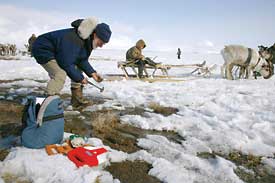Paleontologist helps tell tale of baby mammoth
Extensive studies of a 40,000-year-old baby mammoth carcass discovered in Siberia two years ago validate techniques developed by U-M paleontologist Daniel Fisher for extracting information about prehistoric pachyderms from their teeth and tusks.

Early results of the studies — which involved an international team of researchers and included CT scans, DNA analysis and surgical procedures in addition to tusk and tooth analyses — also are yielding insights into the young woolly mammoth’s brief life and sudden death, and are clarifying aspects of mammoth ecology.
The discovery and subsequent studies of the baby mammoth, known as Lyuba, are the subject of a cover article in the May issue of National Geographic magazine. Fisher’s work also is featured in “Waking the Baby Mammoth,” which aired Sunday on the National Geographic Channel.
Lyuba was remarkably complete and well preserved when discovered on a snowy riverbank in northwestern Siberia by a family of reindeer herders. Missing only toenails and most of her woolly coat, the mammoth looked like a sleeping baby elephant.
Realizing they had found something of great interest to the outside world, reindeer herder Yuri Khudi and local authorities arranged to have the mammoth airlifted to a museum in Salekhard, the regional capital.
Fisher, who has been studying mammoths and mastodons for 30 years, was called in shortly after the discovery. He, French Arctic explorer Bernard Buigues and Russian paleontologist Alexei Tikhonov were among the first to examine the carcass.
Although a number of other mammoth specimens have been found with soft tissues preserved, Lyuba stands out, says Fisher, who is the Claude W. Hibbard Collegiate Professor of Paleontology, with appointments in the U-M Museum of Paleontology and departments of Geological Sciences and Ecology and Evolutionary Biology.
“What makes Lyuba different is the quality and completeness of her preservation,” he says. “No other specimen preserves this much of the original anatomy.”
The team has not reached a consensus about Lyuba’s cause of death, but dense sediment packed into the mammoth’s trunk, mouth and windpipe, along with a peculiar indentation at the base of her trunk, suggest she died of asphyxiation in mud.
Another intriguing question is how Lyuba avoided decomposition and destruction. Undoubtedly she was frozen in permafrost for most of the time between her death and discovery, but Fisher and Buigues determined that the carcass lay on the riverbank for nearly a year before the reindeer herders stumbled upon it.
Based on previous experiments aimed at understanding how Paleolithic hunters stored meat from large animal kills, Fisher believes Lyuba was naturally pickled in lactic acid produced by microbes called lactobacilli. The pickling would have protected her body from decomposition, and the sour smell likely deterred scavengers.
In addition to Fisher, Buigues and Tikhonov, researchers involved in the baby mammoth project include U-M graduate student Adam Rountrey, Naoki Suzuki (Jikei University), Hendrik Poinar (McMaster University), James Tiedje (Michigan State University), Marianne McKelvy (Dow Chemical Co.), Bas van Geel (University of Amsterdam), Frank Rühli (University of Zurich), Chris Strayhorn (School of Dentistry), Scott Beld (Museum of Paleontology), Thure Cerling (University of Utah) and Pavel Kosintsev (Russian Academy of Sciences).

